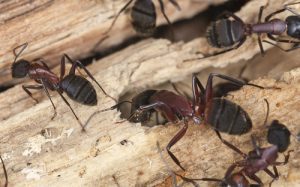Carpenter Ants in the Wall
By Chris Williams on February 1, 2012.
Q. My contractor was doing some work recently, and found a large number of big black ants, some even had wings. I thought ants were dormant in the winter, and could the winged things be termites?
 A: By the sound of it your contractor did find an ant nest. Nest sites are commonly found during repairs or remodeling. The description, “big black ants” does fit that of carpenter ants, and typical nest sites do include wall voids, areas near water damage and or rot, and out of the way spots sometimes encountered during work. Mature carpenter ant nests may contain winged reproductive forms; robust winged females and/or smaller wasp-like males. Carpenter ant nests form when a mated queen ant chews off her wings and seeks shelter. The colony is mobile, but may settle in a desirable location early on. Workers gather food to feed the larvae, who in turn secrete a nutritious fluid to feed the rest of the colony. Larvae pupate to become either workers or reproductive’s. Driven by powerful pheromones given off by the queen, the developmental process yields different ratios of worker/reproductive types depending on the needs of the colony. Carpenter ant colonies are very active in spring and summer, as feeding in trees and shrubs is at its peak. As temperatures cool down and natural food sources begin to subside, so too does ant activity. Carpenter ants will form a group and hibernate within the hollow tree, log, or wall void. As temperatures warm in the spring, the first activity is usually near water sources such as bathrooms, kitchens, and pet water. Once natural food sources return, carpenter ant workers will once again venture outside to hunt.
A: By the sound of it your contractor did find an ant nest. Nest sites are commonly found during repairs or remodeling. The description, “big black ants” does fit that of carpenter ants, and typical nest sites do include wall voids, areas near water damage and or rot, and out of the way spots sometimes encountered during work. Mature carpenter ant nests may contain winged reproductive forms; robust winged females and/or smaller wasp-like males. Carpenter ant nests form when a mated queen ant chews off her wings and seeks shelter. The colony is mobile, but may settle in a desirable location early on. Workers gather food to feed the larvae, who in turn secrete a nutritious fluid to feed the rest of the colony. Larvae pupate to become either workers or reproductive’s. Driven by powerful pheromones given off by the queen, the developmental process yields different ratios of worker/reproductive types depending on the needs of the colony. Carpenter ant colonies are very active in spring and summer, as feeding in trees and shrubs is at its peak. As temperatures cool down and natural food sources begin to subside, so too does ant activity. Carpenter ants will form a group and hibernate within the hollow tree, log, or wall void. As temperatures warm in the spring, the first activity is usually near water sources such as bathrooms, kitchens, and pet water. Once natural food sources return, carpenter ant workers will once again venture outside to hunt.
Termite swarmers are relatively small, uniform in size, and more likely to be found in the spring months during swarming. Termite workers are small opaque to white insects, associated with mud or soil tubes, and do their best work in moist discreet locations. Carpenters find both termite and carpenter ant damage/activity all the time. We strongly recommend having a Pest Control Operator check all suspect activity for a positive I.D. Safe and Effective treatment for both termites and carpenter ants is available.